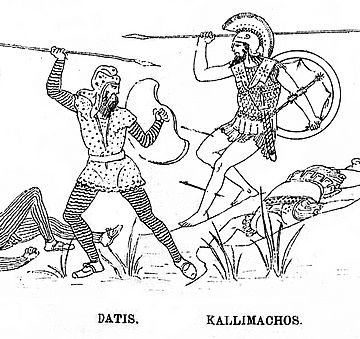Datis facts for kids
Quick facts for kids
Datis
|
|
|---|---|

Datis fighting Kallimachos at the Battle of Marathon, in the Stoa Poikile (reconstitution)
|
|
| Native name |
*Dātiya-
|
| Born | Media, Achaemenid Empire |
| Allegiance | Achaemenid Empire |
| Battles/wars | Ionian Revolt
First Persian invasion of Greece
|
Datis, also known as Datus, was an important noble and admiral from Media. He served the powerful Persian Empire when Darius the Great was king. Datis knew a lot about the Greeks and had connections with their leaders. He is famous for leading the Persian army with Artaphernes during the first part of the Persian Wars against the Greeks.
Contents
Datis's Life and Military Actions
Early Military Role
Before the main Persian Wars, Datis was a Persian commander. He fought during the Ionian Revolt, which was a rebellion by Greek cities against Persian rule. In 494 BCE, Datis led the Persian forces to fight back against the Ionians.
Orders from King Darius
Datis and another officer named Artaphernes took over from a commander named Mardonius. King Darius ordered Datis to conquer Athens and Eretria. He was told to bring the people of these cities back to the Persian king as captives. To do this, Datis planned to create a strong base on the eastern coast of Greece.
Journey to the Greek Islands
In 490 BCE, Datis sailed from the Ionian coast. He first went to Samos, then through the Icarian Sea to the islands of Delos and Naxos. When Datis arrived, the people on these islands ran away. Datis sent them a message, saying he did not want to harm them. On Delos, Datis burned a lot of incense at the altar of Apollo, showing respect.
Capturing Greek Towns
Datis's army moved along the Greek coast, taking over towns one by one. One town called Carystus tried to fight back. Datis's large army, which had about 80,000 soldiers and 200 warships called triremes, surrounded the city. He started by destroying the crops around Carystus. Eventually, the city was defeated and surrendered to Datis.
The Siege of Eretria
In 490 BCE, Datis began to surround and attack Eretria. The people of Eretria had different ideas about what to do. Some wanted to give up the city and fight a "guerrilla war" (small, surprise attacks) in the mountains. Others wanted to surrender to the Persians right away. Four thousand Athenian settlers came from Chalcis to help defend Eretria.
Datis's forces attacked the Eretrians in battle, and many people were hurt or killed. On the seventh day of the attack, the Eretrians surrendered. All the temples in the city were burned. This was revenge for the Greeks burning the city of Sardis earlier. It is very likely that the temple of Apollo Daphnephoros was one of the temples destroyed.
The Battle of Marathon
Datis led the Persian attack force against the Athenians at the Battle of Marathon in the same year. A historian named Ctesias wrote that Datis was killed at Marathon. He also said the Athenians refused to give his body back. However, another famous historian, Herodotus, wrote that Datis survived the battle. So, it is not fully clear what happened to him after Marathon.
Datis's Family
Datis had two sons named Harmamithres and Tithaeus. Both of his sons grew up to become cavalry officers. They served under Xerxes I, who was the son of Darius the Great.
See also
 In Spanish: Datis para niños
In Spanish: Datis para niños

